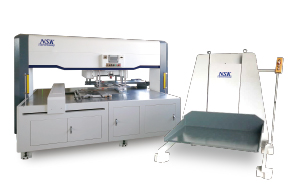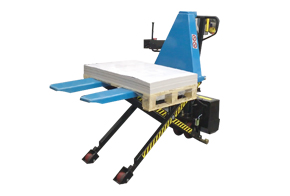A Work Environment Improved Through MBM

Takada Shikosho Co., Ltd.
Mr. Takada
Representative Director
Takada Shikosho (Takada Paper Works) has specialized consistently in package
blanking since its establishment in 1968 in Osaka City. At the beginning, the company
started with one manually fed Thomson guillotine, growing steadily until moving in 1995
to an expanded facility.
It is a vibrant company that now owns a total of 5 Thomson machines, despite its
staff numbers, and continues to offer packaging of the highest quality.

"One of the appeals of introducing MBM was the shortening of turnaround times, but I think quality improvement by mechanizing the blanking process is another major benefit."

The Automatic Lift Hand Fork introduced together
with the MBM reduces the strain of lifting materials
to the work area.
What made you decide to introduce the Multi Blanking Machine?
Mr. Takada : "There were two major goals in mechanizing the blanking process. The first goal was to reduce labor costs and improve blanking quality. The second was to promote the growth of the company and employee skills by improving factory operations."
Please tell us more about your labor reduction and quality improvement goals.
Mr. Takada "At our company, all blanking was done completely by hand before installing the MBM. I think it can be said for all companies that do punching and stripping work, but this work is both hard and time-consuming. In the busy seasons, all of the employees would be asked to assist with this punching work. Because our staff numbers are not very high, if other employees are asked to take care of this work, other projects may be delayed or slowed down. A constant problem was that employees took a lot of overtime to handle this work. One purpose of installing an MBM was to improve this issue.
Another major purpose of the installation was to improve the quality of our products. Manual labor always comes with risks such as dents from tools, or adhesion of substances such as blood from an injury. Of course, I always pay close attention to prevent this sort of issue, but doing so also reduces work efficiency and causes great stress for the employees. Only machines can solve this kind of problem, and it is another reason for our introduction of MBM to the factory.
How do you hope to improve the growth of the employees together with your company and achieve your second goal?

Demanding manual labor together with high-precision
care not to damage products creates a heavy burden.
MBM was introduced to reduce this kind of issue.
Mr. Takada "Simple hard work with little skill improvement is difficult. For long hours, the same repetitive task must be done over and over with little to no skills to learn or obtain from it. For employees, this brings down motivation, and I felt that we were losing opportunities to work on new things.
Also, during recruitment activities for potential hires, in the past I would sometimes show them the job site at the time of the interview. However, they would see the area for manual blanking work and decline the job offer. There is a high possibility that this works against us for hiring new employees, so I try to avoid showing it if possible, but since blanking is a part of the job that cannot be avoided, I cannot hide it. This has resulted in a shortage of personnel."
"Fortunately, we have a successor to continue the business, which is helpful as the shortage of successors to specialized work has become a serious issue in the industry. I am glad about this, but I feel uneasy about leaving this harsh situation to a successor without any ideas in place. While I am in the office, I hope to improve the on-site environment and make it easy for employees to take on challenges and new skills. Not only the employees, but the company itself will lay down the foundation for new growth. I believe that helping the employees and company step up is a responsibility for me."
◆
Mr. Takada explained that the introduction was based on the idea that mechanization of blanking is indispensable for both labor reduction and for the growth of both employees and the company.
What made you choose the MBM?
Mr. Takada "At our company, most jobs have 5000 to 6000 pieces, but the biggest factor was that the MBM has the most balanced specifications in terms of our business scale. I saw two types of machine beforehand: A hand-type stripping machine and a fully automatic type. The hand type did not do much for labor reduction, and I do not want to implement a solution that would only compliment the current work. The automatic type placed a heavy burden on the operator because it was necessary to make a separate frame as part of the pre-setup. It was highly functional in terms of specs but I felt that the performance was excessive for our standard project sizes. The work area was also small and there were no other products that met our needs."
"Around that time, I was informed that Habe Taiyodo in Kyoto would hold an open house event for their installed MBM, so I attended with our managing director and junior employees. To be honest, I had low expectations, but I was contacted by the event site and were sent videos of the machine that showed us how easy it was to operate. After that, we made an evaluation of the machine, confirmed that it matched our business style, and decided to introduce it. In addition to a reasonable price, it does not require preparation of any additional equipment, and the slim horizontal design made it flexible for the factory layout. It was exactly the machine I was looking for."
What were your initial impressions of the machine?


Almost all work can be completed in front of the machine
Mr. Takada "Employees who visited the open house operated the machine as it was set up, but my impression from seeing the MBM was that the machine is very simple to operate: Just setting up pins, setting up the product position, and the blanking itself. I heard that work efficiency is high because both machine operation and waste removal are completed in one place, and there is no need to move around. I thought it would take time to get used to the machine, but I was pleasantly surprised that the machine was started up earlier than I expected."
What effect has the MBM introduction had?
Mr. Takada "First of all, we have achieved our two goals of labor reduction and quality improvement with great success. At this stage, average operation covers three or four projects with 5000 to 6000 pieces each. All of these now only take five hours total to complete. In a larger project size, I could do 50,000 pieces in less than a day and a half. This is almost the same pace as manual stripping; the difference is that with MBM, I can do the same by myself.
In terms of quality, of course, we can reduce losses due to scratches and dirt, but we did not expect the reduction of paper dust. I think that the uniform force applied by the MBM helps to reduce paper dust. Overtime is also steadily decreasing as well, so we plan to continue full-scale efforts to achieve the second goal of employee growth."
Finally, please tell us about your future business outlook.
Mr. Takada "I would firstly like to actively promote to customers in order to win new projects. One of the appeals of introducing MBM was the shortening of turnaround times, but I think quality improvement by mechanizing the blanking process is another major benefit. We manage many high quality cosmetics and food packaging jobs, and the quality demands compared to the olden days are higher and higher every year. Sometimes you may be required to achieve rigorously strict levels of quality. With MBM, we feel we can respond to those needs with confidence.
In the future, we believe that the industry will move away from plastics more, and will be replaced by the adoption of paper-based packaging. In that case, we will have the MBM for the variety of shapes that will come with that trend. The future of the company will be greatly influenced by smart processing that makes effective use of machines, rather than complete dependence on them. Business improvements thanks to MBM have only just begun, and I hope to implement work style reforms so they can work together and grow."
Solutions Introduced
MBM Multi Blanking Machine For short-run production

More Info A punching machine released as a solution for short-run for extruding packaging, cards, mounts, labels and more. There is no need to create a blanking die, and it can handle a wide variety of product sizes and shapes.
Automatic Lift Hand Fork
 More Info
A hand fork with an automatic lifting function that anyone can easily operate.
The automatic lift brings materials to the height of the work station, allowing
a reduction of the burden of manual labor on workers and saving on time allocated
to movement. It can easily be introduced as a compliment to existing equipment.
More Info
A hand fork with an automatic lifting function that anyone can easily operate.
The automatic lift brings materials to the height of the work station, allowing
a reduction of the burden of manual labor on workers and saving on time allocated
to movement. It can easily be introduced as a compliment to existing equipment.